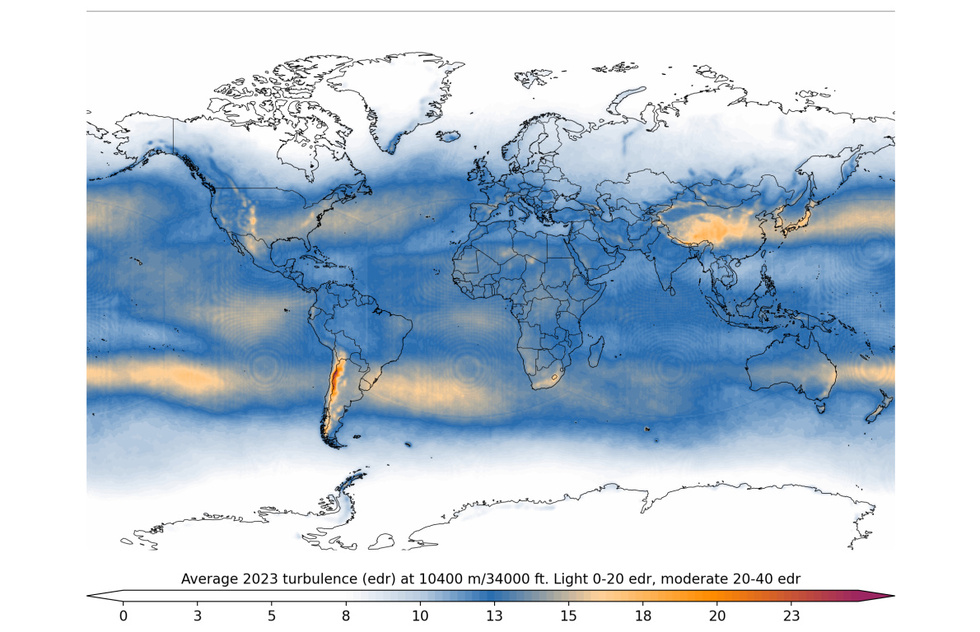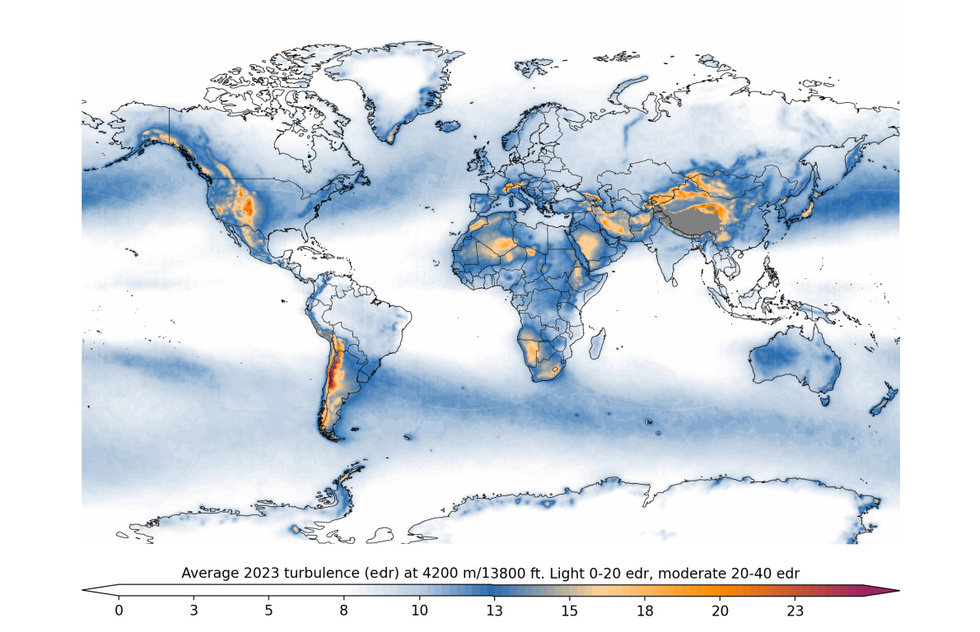Because in-flight turbulence can occur with little warning, predicting whether a ride in the sky will be bumpy or smooth is not easy—in fact, the most dependable weather models won't hazard a forecast for more than a day or so into the future.
However, historical data can teach us something about the conditions under which turbulence is more likely to rattle an airliner, according to Ignacio Gallego-Marcos, a Sweden-based specialist in turbulence modeling and computational fluid dynamics.
Gallego-Marcos is the mastermind behind Turbli, a website where users can get free turbulence forecasts for flights up to 36 hours in advance, based on data from the U.S. National Oceanic and Atmospheric Administration and other sources.
"The most turbulent regions," Gallego-Marcos told Frommer's in an email, "are those that combine high jet stream activity and high mountain ranges." Consequently, "the area with highest turbulence is the Andes, followed by Japan and the Himalayas."
You can see that to be true in a pair of world maps that Gallego-Marcos shared with us—one showing 2023's average turbulence levels at 13,800 feet (pictured at the top of this post) and another showing the year's average turbulence at the standard cruising altitude of 34,000 feet, pictured below.
 (World map showing average turbulence at 34,000 feet in 2023 | Credit: Turbli)
(World map showing average turbulence at 34,000 feet in 2023 | Credit: Turbli)
The graphics are heat maps, so any areas shaded closer to the red end of the spectrum rather than the blue indicate higher levels of turbulence.
As you can see, the mountainous regions Gallego-Marcos highlights—particularly the Andes of South America and the Himalayas of Asia—sport the warmest shades on the map.
Turbli's data was also used to rank the flight routes with the most turbulence in 2023. Here are the 10 routes that had the highest average turbulence levels overall:
- 1. Santiago, Chile (SCL) – Santa Cruz, Bolivia (VVI)
- 2. Almaty, Kazakhstan (ALA) – Bishkek, Kyrgyzstan (FRU)
- 3. Lanzhou, China (LHW) – Chengdu, China (CTU)
- 4. Centrair, Japan (NGO) – Sendai, Japan (SDJ)
- 5. Milan (MXP) – Geneva (GVA)
- 6. Lanzhou – Xianyang, China (XIY)
- 7. Osaka, Japan (KIX) – Sendai
- 8. Xianyang – Chengdu
- 9. Xianyang – Chongqing, China (CKG)
- 10. Milan – Zurich (ZRH)
No North American routes made the top 10, but Turbli's continent-by-continent rankings revealed that flights navigating the Appalachian and Rocky mountains endured the most U.S.-based turbulence in 2023, with the Nashville, Tennessee (BNA) – Raleigh-Durham, North Carolina (RDU), route ranking first, followed by Charlotte, North Carolina (CLT) – Pittsburgh (PIT) in second, and Denver (DEN) – Puerto Vallarta, Mexico (PVR), in third.
You can see the complete breakdown by continent as well as the previous year's rankings at Turbli's website.
The site also has a list of 2023's most turbulent airports, based on an average measured over a 100km (62-mile) diameter circle surrounding the facility, at its base elevation, and at 4,000m (13,000 ft.) above it.
Chile's capital came in first in that ranking, too. Here are the five airport locations with the most turbulence in their immediate vicinity, according to Turbli:
1. Santiago, Chile
2. Sendai, Japan
3. Wellington, New Zealand (WLG)
4. Sapporo, Japan (CTS)
5. Osaka
All 10 of North America's most turbulent airports, meanwhile, are on the western side of the continent, starting with the top three: Portland, Oregon (PDX); Denver; and Las Vegas (LAS), in that order.
Go to Turbli's website for the full airport rankings.
If you're worried about encountering turbulence on your next flight, try to keep in mind that in-flight bumpiness—though unpleasant and increasingly common—hardly ever results in injuries for passengers and that instances of turbulence causing major damage to aircraft are vanishingly rare.
As aviation meteorology expert Thomas Guinn advised passengers in a Frommer's story from last spring, "Put your seat belt on and leave it on. There’s very little that can hurt you if you stay seated, if you’re buckled in.”






